
|
 |

|
 |
Pavakathakali - Kapila Venu e-mail: abhinayakairali@gmail.com December 4, 2011 Pavakathakali or Puppet Kathakali is an art form that has had its share in making Kathakali, the classical dance theatre of Kerala, popular even from the time of its evolution. It is possible to see in different regions across cultures the puppet version of their important art forms. Bunraku is thus the puppet version of the Japanese Kabuki; the Chinese puppet theatre has elements that compare with the Beijing Opera. The dance drama Yakshagana from Karnataka in India has with regional variations its incarnation in the Yakshagana puppet. The fact underlined is that when children and adults see a character unfold through puppets, it leaves a strong impression in their minds. In olden times, puppeteers all over the world travelled a lot. They would bundle up their puppets and travel across villages, from house to house and perform in the domestic space for children and adults. When such itinerant performers arrived in the ancestral homes, the hosts paid a lot of attention to take care of their needs for the performances generated a lot of excitement in children. 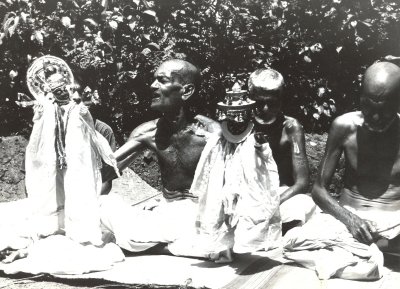 Chamu Pandaram and troupe (Photo: Sangeet Natak Akademi) 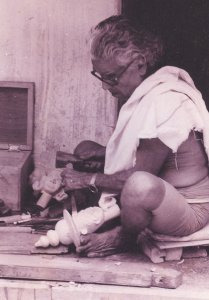 Thottassery Narayanan Nambutiri In Kerala, for the Aandipandaras, such performances are traditionally the means of their livelihood. There continue to be some families of such itinerant performers in Paruthippulli and Kodumbu villages in Palakkad. Though they had migrated from Andhra Pradesh many centuries back and settled here, their mother tongue continues to be Telugu. The means for their main source of income was to offer puja in households for Lord Subramanya and guide pilgrims on their way to Palani. Apart from this, some of them were good in various types of performances. It was a small group from among these who worked as puppeteers. It is believed that they came from Andhra Pradesh via Tamil Nadu and settled in Kerala. When they reached Kerala, they used to perform the Aryamaala, the Tamil folk drama as puppet show. Later when Kathakali became popular in Kerala, they carved Kathakali figures, studied the text and shaped it to make it their own art form. They did get a lot of encouragement and acceptance for this. In the modern period, at least till the 1960s, Pavakathakali was very much alive. Chamu Pandaram was a noted artist in the twentieth century. A troupe from Paruthippulli village under the leadership of Chamu Pandaram travelled from household to household with their performances covering regions till the Purnathrayeesha temple in Thripunithura. Kamaladevi Chattopadhyay who happened to see two such puppets in the museum in Thrissur first underlined the need to revive this art form. She was instrumental in providing the impetus and support to revive most of the puppet forms in India. Later, she entrusted Venu G to continue with research in this area. Acharya Krishnankutty Pulavar, the leather puppetry maestro's help was instrumental in getting to know that Chamu Pandaram and his troupe were in Paruthippulli village. 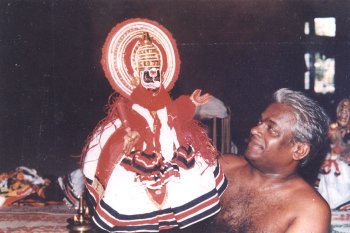 G Venu with a Pavakathakali puppet 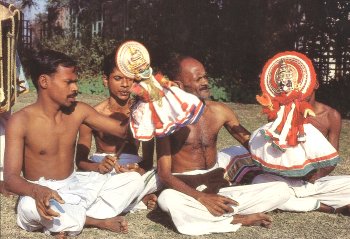 KC Ramakrishnan, KV Ramakrishnan and KC Karuppan rehearsing for 'Kalyanasaugandhikam' at Natanakairali (1984) In 1972, with the help of the documentation officer Govind Vidyarthi of Sangeet Natak Akademi, New Delhi, the Paavakathakali of Chamu Pandaram was filmed in 16mm. It can be said that this was the only documentation of Paavakathakali during that period. In 1980, according to the suggestions of Kamaladevi-ji, there was an elaborate survey that G Venu undertook. Then with the help of KV Ramakrishnan, the nephew of Chamu Pandaram, many puppets and other details were collected. When the training program for reviving Pavakathakali was initiated by the Sangeet Natak Akademi in 1982, the main performers Chamu Pandaram and his colleague Velayudhan Pandaram had passed away. Only KV Ramakrishnan, the son of Velayudhan Pandaram, KC Karuppan, KC Ramakrishnan, the children of Chamu Pandaram, percussionist V Thankappan remained in the traditional family who could just about handle the art form. But none of them had the expertise to make puppets. Thottassery Narayanan, Kathakali artist and costume designer took it on himself to make the puppets studying the old puppets. Six students were selected from Puthuppulli and Kodumbu villages for training. Ravi Gopalan Nair was the student who studied the art of making puppets. The overall responsibility of training was in Venu G known for his knowledge of Kathakali and Pavakathakali. The venue for training was provided by Vijnanakalavedi, the Chengannur based Kathakali Vidyalayam. After almost one year, the venue was shifted to Natanakairali, Irinjalakuda. Since those students selected for training from the Aandipandaram family went for training in other professions, they were not available for Pavakathakali. 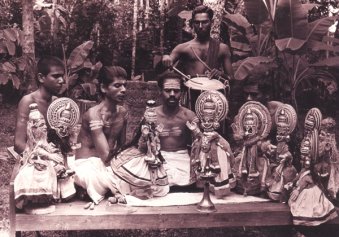 A scene from 'Uttaraswayamvaram' 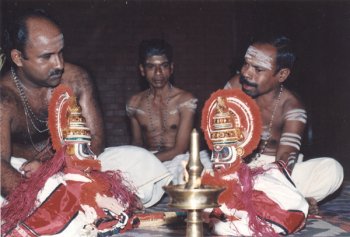 K Sreenivasan, KV Ramakrsihnan and KC Ramakrishnan rehearsing 'Balivadham' In 1984 when Venu G choreographed the story of Kalyana Sougandhikam for Pavakathakali revived by Kamaladevi-ji, it was presented at the India International Centre, New Delhi. Following this Duryodhanavadham, Dakshayagam and Utharaswayamvaram were also choreographed. Pavakathakali had numerous stages in India and abroad and became popular across the world. At present, there is only a small troupe at Natanakairali to preserve this art form. This troupe has at present KV Ramakrishnan, KC Ramakrishnan, Ravi Gopalan Nair, K Srinivasan, V Thankappan, and Kalanilayam Ramakrishnan. With the national award from the Kendra Sangeet Natak Akademi to KV Ramakrishnan and KC Ramakrishnan in 2011 and the Dakshina Chitra Viruthu award for Ravi Gopalan Nair, this art form has received a boost for its morale. 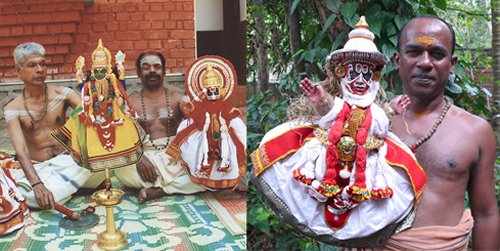 KV Ramakrishnan, KC Ramakrishnan and Ravi Gopalan Nair It is imperative to nourish and nurture a new generation in Pavakathakali. This kind of working with art forms is not a way to earn one's living. Only those who have a regular job and can handle this art form simultaneously can properly train in this. Rigorous training for at least six years is essential if one has to ably perform with rhythmic modulations and gain mastery over the art. Kapila Venu, daughter of Nangiarkoothu guru Nirmala Paniker and G Venu, is the disciple of legendary Koodiyattam maestro Guru Ammannur Madhava Chakyar. She has also trained in Koodiyattam under G Venu, Usha Nangiar and Kitangur CN Rama Chakyar. Post your comments Please provide your name and email id when you use the Anonymous profile in the blog to post a comment. All appropriate comments posted with name & email id in the blog will also be featured in the site. |